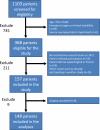Preoperative anxiety as a predictor of mortality and major morbidity in patients aged >70 years undergoing cardiac surgery
- PMID: 23245838
- PMCID: PMC3677723
- DOI: 10.1016/j.amjcard.2012.08.060
Preoperative anxiety as a predictor of mortality and major morbidity in patients aged >70 years undergoing cardiac surgery
Abstract
The present study examined the association between patient-reported anxiety and postcardiac surgery mortality and major morbidity. Frailty Assessment Before Cardiac Surgery was a prospective multicenter cohort study of elderly patients undergoing cardiac surgery (coronary artery bypass surgery and/or valve repair or replacement) at 4 tertiary care hospitals from 2008 to 2009. The patients were evaluated a mean of 2 days preoperatively with the Hospital Anxiety and Depression Scale, a validated questionnaire assessing depression and anxiety in hospitalized patients. The primary predictor variable was a high level of anxiety, defined by a Hospital Anxiety and Depression Scale score of ≥ 11. The main outcome measure was all-cause mortality or major morbidity (e.g., stroke, renal failure, prolonged ventilation, deep sternal wound infection, or reoperation) occurring during the index hospitalization. Multivariable logistic regression analysis examined the association between high preoperative anxiety and all-cause mortality/major morbidity, adjusting for the Society of Thoracic Surgeons predicted risk, age, gender, and depression symptoms. A total of 148 patients (mean age 75.8 ± 4.4 years; 34% women) completed the Hospital Anxiety and Depression Scale. High levels of preoperative anxiety were present in 7% of patients. No differences were found in the type of surgery and Society of Thoracic Surgeons predicted risk across the preoperative levels of anxiety. After adjusting for potential confounders, high preoperative anxiety was remained independently predictive of postoperative mortality or major morbidity (odds ratio 5.1, 95% confidence interval 1.3 to 20.2; p = 0.02). In conclusion, although high levels of anxiety were present in few patients anticipating cardiac surgery, this conferred a strong and independent heightened risk of mortality or major morbidity.
Copyright © 2013 Elsevier Inc. All rights reserved.
Figures
Comment in
-
Anxiety and depression as predictors of cardiovascular outcomes after cardiac surgery.Am J Cardiol. 2013 Apr 1;111(7):1079. doi: 10.1016/j.amjcard.2013.01.001. Am J Cardiol. 2013. PMID: 23498090 No abstract available.
-
Reply: To PMID 23245838.Am J Cardiol. 2013 Apr 1;111(7):1079. doi: 10.1016/j.amjcard.2013.01.002. Am J Cardiol. 2013. PMID: 23498091 No abstract available.
References
-
- Frasure-Smith N, Lesperance F, Talajic M. Depression following myocardial infarction. Impact on 6-month survival. JAMA. 1993;270:1819–1825. - PubMed
-
- Gullette EC, Blumenthal JA, Babyak M, Jiang W, Waugh RA, Frid DJ, O'Connor CM, Morris JJ, Krantz DS. Effects of mental stress on myocardial ischemia during daily life. JAMA. 1997;277:1521–1526. - PubMed
-
- Arnold SV, Spertus JA, Ciechanowski PS, Soine LA, Jordan-Keith K, Caldwell JH, Sullivan MD. Psychosocial modulators of angina response to myocardial ischemia. Circulation. 2009;120:126–133. - PubMed
-
- Martens EJ, de Jonge P, Na B, Cohen BE, Lett H, Whooley MA. Whooley, Scared to death? Generalized anxiety disorder and cardiovascular events in patients with stable coronary heart disease:The Heart and Soul Study. Arch Gen Psychiatry. 2010;67:750–758. - PubMed
-
- Roest AM, Martens EJ, Denollet J, de Jonge P. Prognostic association of anxiety post myocardial infarction with mortality and new cardiac events: a meta-analysis. Psychosom Med. 2010;72:563–569. - PubMed
Publication types
MeSH terms
Grants and funding
LinkOut - more resources
Full Text Sources
Other Literature Sources
Medical



